The Healthcare Mobile Computers Market is estimated to be valued at USD 1.4 billion in 2025 and is projected to reach USD 2.3 billion by 2035, registering a compound annual growth rate (CAGR) of 5.0% over the forecast period.
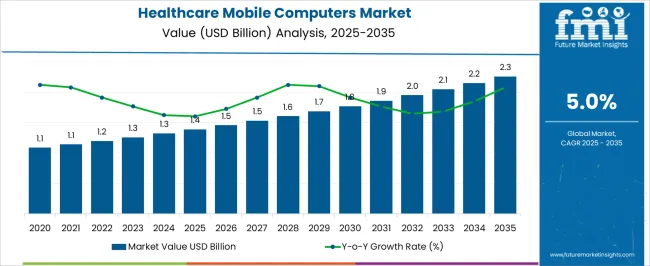
| Metric | Value |
|---|---|
| Healthcare Mobile Computers Market Estimated Value in (2025 E) | USD 1.4 billion |
| Healthcare Mobile Computers Market Forecast Value in (2035 F) | USD 2.3 billion |
| Forecast CAGR (2025 to 2035) | 5.0% |
The healthcare mobile computers market is showing consistent expansion, supported by the rising adoption of digital technologies aimed at improving patient care, operational efficiency, and data accessibility within healthcare facilities. Growth is being fueled by increasing investments in digital transformation strategies by hospitals and clinics, driven by the need to enhance clinical workflows and reduce administrative burdens. Mobile computers, including tablets and smartphones, are enabling seamless access to electronic health records, real-time communication, and telemedicine services, which are critical in the evolving healthcare landscape.
The market is further benefitting from the growing emphasis on mobility, interoperability, and secure data management across care settings. Technological advancements in software applications tailored for healthcare use are also strengthening adoption, ensuring integration with hospital information systems and compliance with data security standards.
Rising demand for point-of-care solutions, coupled with the global trend toward patient-centered care, is expected to keep driving growth As healthcare providers continue prioritizing efficiency and outcomes, mobile computing solutions are positioned to become a cornerstone of modern healthcare delivery worldwide.
The healthcare mobile computers market is segmented by product & services, software applications, end-users, and geographic regions. By product & services, healthcare mobile computers market is divided into Mobile computers (tablets and smartphones), Mobile devices, Mobile software applications, Enterprise platforms, and Handheld scanners (RFID & barcode scanners). In terms of software applications, healthcare mobile computers market is classified into Patient care management, Operations management, and Staff management. Based on end-users, healthcare mobile computers market is segmented into Providers, Payers, and Patients. Regionally, the healthcare mobile computers industry is classified into North America, Latin America, Western Europe, Eastern Europe, Balkan & Baltic Countries, Russia & Belarus, Central Asia, East Asia, South Asia & Pacific, and the Middle East & Africa.
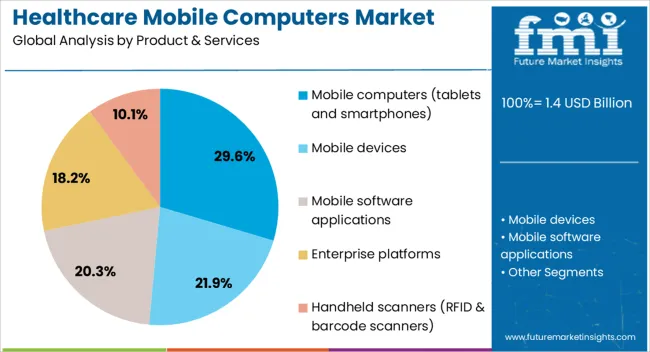
The mobile computers segment, comprising tablets and smartphones, is projected to hold 29.6% of the healthcare mobile computers market revenue share in 2025, making it the leading product and services category. This dominance is being driven by the increasing demand for portable and multifunctional devices that streamline clinical workflows and improve patient care delivery. Tablets and smartphones are being widely utilized for accessing electronic health records, communicating with care teams, and supporting diagnostic applications at the point of care.
The flexibility and user-friendly interfaces of these devices enhance usability among healthcare professionals, allowing faster adoption compared to traditional desktop systems. The integration of advanced software applications tailored for healthcare further strengthens their role in delivering real-time data access and secure communication.
Additionally, cost-effectiveness and scalability have positioned mobile computers as a preferred choice for both large hospitals and smaller clinics With the rising need for mobility, efficiency, and improved patient engagement, mobile computers are expected to maintain their leadership as a critical component of digital healthcare infrastructure.
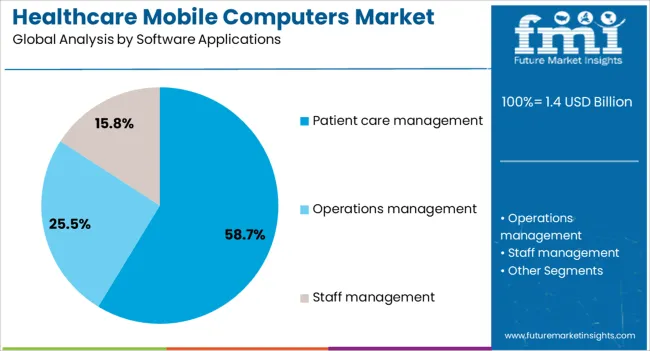
The patient care management segment is anticipated to represent 58.7% of the healthcare mobile computers market revenue share in 2025, establishing itself as the leading application area. This dominance is being fueled by the increasing emphasis on improving patient outcomes, streamlining care delivery, and enhancing clinical decision-making. Mobile computing solutions are enabling healthcare providers to monitor, record, and analyze patient data in real time, leading to more accurate and timely interventions.
Integration of patient care management software with mobile devices allows clinicians to access medical histories, diagnostic information, and treatment plans directly at the bedside. This not only reduces medical errors but also strengthens patient engagement by ensuring transparency and improved communication.
The growing adoption of telehealth and remote monitoring solutions is further supporting the expansion of this segment As healthcare systems continue to focus on value-based care models and efficiency, the role of mobile computing in patient care management is expected to grow steadily, reinforcing its leadership within the market.
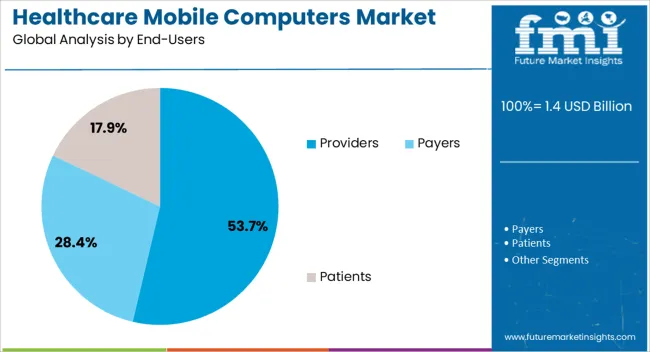
The providers segment is expected to capture 53.7% of the healthcare mobile computers market revenue share in 2025, making it the dominant end-user category. This leadership is being explained by the increasing reliance of hospitals, clinics, and outpatient centers on mobile computing devices to enhance operational efficiency and improve patient care. Providers are leveraging mobile computers to ensure seamless access to electronic health records, facilitate real-time collaboration between medical teams, and support diagnostic and treatment processes.
The segment’s growth is being further reinforced by rising adoption of mobile-enabled solutions for medication administration, patient monitoring, and workflow optimization. Integration of mobile computers with hospital information systems and compliance with healthcare data privacy regulations are improving trust and accelerating deployment.
Cost savings, efficiency improvements, and enhanced patient satisfaction are among the key outcomes driving adoption As healthcare facilities continue to invest in digital transformation initiatives, providers are expected to remain the largest contributors to market demand, solidifying their leadership position in the healthcare mobile computers market.
Specialized products for the healthcare industry that is designed to operate in the Hospital Data Framework
Features such as s 2D scanning, easy data collection, biometric recognition, and patient wristband scanners.
Recent innovations in the healthcare mobile computer market have enabled the secure transfer of data within medical institutions. This has propelled key industry players to develop innovative products that cater to specialized user concerns.
These include department-specific technological innovations that promote secure communication of confidential medical records and patient information. Recent cyberattacks on hospital data systems are a key healthcare mobile computer market restraint.
There is increasing worry about maintaining the confidentiality of sensitive patient information and the need for cybersecurity for hospitals' digital data storage systems. Hence, industry leaders need to develop advanced technology-embedded healthcare mobile systems that are highly secure to improve consumer confidence.
Developed nations in North America and Europe are expected to hold the largest market share during the forecast period. The availability of advanced medical technologies, coupled with greater patient access to technology, is the major growth factor.
Further, the medical systems in these regions, such as those of Canada, the United States, and the UK, started the digitization process much earlier than the developing and under-developed nations. Thus medical data management systems are much more advanced and efficient.
Due to the increased digitization of diverse demographics, the Asia-Pacific region is expected to record a promising CAGR during the forecast period. This is bolstered by increasing investment in public healthcare systems as well as the adoption of advanced technologies such as 5G in the region.
Healthcare mobile computing involves use of mobile devices and enterprise platforms to communicate and efficiently manage exchange of medical data among several end users. The use of mobile computing and applications can help make this changeover across healthcare amenities, resulting in fewer hospitals readmissions and augmented patient's outcomes.
Mobile computers enable healthcare service providers to have access to patient information on-demand and at any location within the facility, ensuring the highest quality care possible at cost effective price.
Currently, the healthcare industry is witnessing use of point-of-care computing solutions including laptops, smartphones, tablets, handheld scanners, RFID readers, and mobile carts owing mainly to affordability, ease in accessibility, and timely medical assistance provided by these devices.
The market of healthcare mobile computers is expected to observe hefty growth during the forecast period due to various factors such as: increase in adoption rate of mobile computers such as smartphones and tablets in healthcare units, better cost efficiency of mobile computing solutions, rising focus towards patient-centric applications, rapid rise in penetration of wireless networks such as 3G & 4G, shortage of nursing staff and doctors promoting the adoption of mobile computing solutions.
In addition to that, mobile computers are resolving most of the major challenges confronted by the healthcare industry including rising costs & error rates, decreasing profitability, fast-changing regulatory environment and demand for quality healthcare, by making healthcare organizations more responsive to the market demand.
Data security issues, lack of standard communication protocols and reimbursement policies, short battery life of mobile computers are few constraint which are expected to hamper the growth of market in the near future.
Presently, North America and Europe are one of the major regions witnessing the adoption of the healthcare mobile computers.
The primary factors attributing to the market growth in these regions are; high dissemination of mobile devices, development and adoption of pioneering technologies, and the presence of major companies in this region, which improves consumer approachability to mobile computers.
However, the future growth of the global market of healthcare mobile computers will be driven by the Asia-Pacific and Latin America mainly due to the upsurge in number of healthcare organizations such as hospitals, nursing homes, clinics and other ambulatory care services.
Additionally, increasing frequency of chronic diseases and disorders which demands continuous patient monitoring is also one of the key factors expected to strengthen the growth of mobile devices in this region.
Growth in these regions is expected to be centred on developing economies such as India, China, Singapore, South Korea, UAE, Brazil, Argentina, and Mexico. This is due to the fact that these economies facilitate modified guidelines and are continuously monitoring the implementation of procedures and policies to promote commercialization and innovations in order to attract global investors.
Japan is also one of the significant region witnessing adoption of healthcare mobile computers. The growth is mainly driven by rising geriatric population, leading to susceptibility to chronic diseases and penetration of mobile computers such as smartphones and tablets in the country.
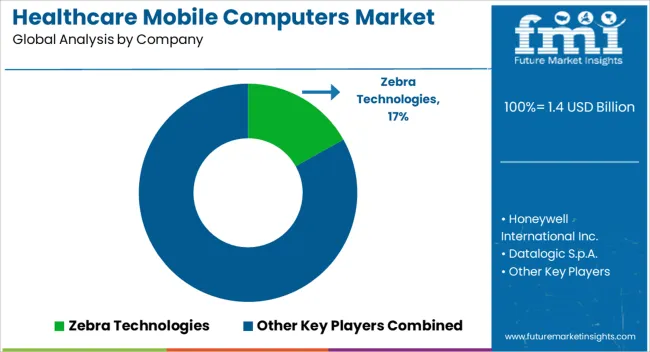
Some of the prominent players in the healthcare mobile computers market include Cisco Systems Inc. (USA), Oracle Corporation (USA), AT&T Inc. (USA), Zebra Technologies Corporation (USA), Airstrip Technologies, Inc. (USA), Cerner Corporation (USA), McKesson Corporation (USA), Omron Corporation (Japan), SAP SE (Germany), and Philips Healthcare (Netherlands). Other key players include Microsoft Inc. (USA), Apple Inc. (USA), Hewlett-Packard (HP) Inc. (US), Qualcomm Inc. (USA), IBM Corporation (USa), and Verizon Communications, Inc. (USA).
Decreasing price of electronic components have observed entry of many players in this market. Regional players are becoming a major threat and are further propelling the competition among existing leaders.
In order to maintain their market share, leading players are involved in upgrading their existing products and services. Innovation as a key solution to obtain competitive edge is anticipated to drive innovation in the market, which in turn would help healthcare industry to overcome the challenges associated with mobile computing solutions.
North America
US & Canada
Latin America
Brazil, Argentina & Others
Europe
Asia Pacific
Japan
Middle East and Africa
The report is a compilation of first-hand information, qualitative and quantitative assessment by industry analysts, inputs from industry experts and industry participants across the value chain.
The report provides in-depth analysis of parent market trends, macro-economic indicators and governing factors along with market attractiveness as per segments. The report also maps the qualitative impact of various market factors on market segments and geographies.
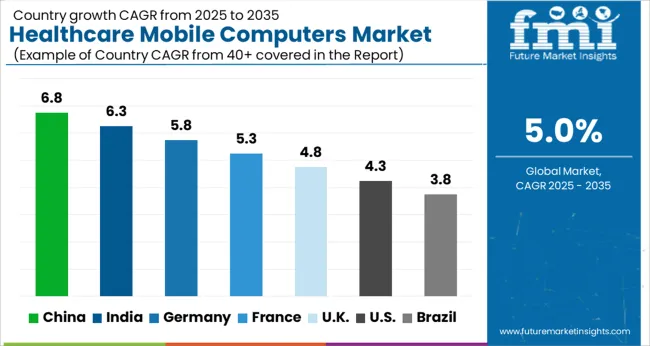
| Country | CAGR |
|---|---|
| China | 6.8% |
| India | 6.3% |
| Germany | 5.8% |
| France | 5.3% |
| UK | 4.8% |
| USA | 4.3% |
| Brazil | 3.8% |
The Healthcare Mobile Computers Market is expected to register a CAGR of 5.0% during the forecast period, exhibiting varied country level momentum. China leads with the highest CAGR of 6.8%, followed by India at 6.3%. Developed markets such as Germany, France, and the UK continue to expand steadily, while the USA is likely to grow at consistent rates. Brazil posts the lowest CAGR at 3.8%, yet still underscores a broadly positive trajectory for the global Healthcare Mobile Computers Market. In 2024, Germany held a dominant revenue in the Western Europe market and is expected to grow with a CAGR of 5.8%. The USA Healthcare Mobile Computers Market is estimated to be valued at USD 508.8 million in 2025 and is anticipated to reach a valuation of USD 771.5 million by 2035. Sales are projected to rise at a CAGR of 4.3% over the forecast period between 2025 and 2035. While Japan and South Korea markets are estimated to be valued at USD 66.6 million and USD 45.8 million respectively in 2025.
| Item | Value |
|---|---|
| Quantitative Units | USD 1.4 Billion |
| Product & Services | Mobile computers (tablets and smartphones), Mobile devices, Mobile software applications, Enterprise platforms, and Handheld scanners (RFID & barcode scanners) |
| Software Applications | Patient care management, Operations management, and Staff management |
| End-Users | Providers, Payers, and Patients |
| Regions Covered | North America, Europe, Asia-Pacific, Latin America, Middle East & Africa |
| Country Covered | United States, Canada, Germany, France, United Kingdom, China, Japan, India, Brazil, South Africa |
| Key Companies Profiled | Zebra Technologies, Honeywell International Inc., Datalogic S.p.A., Advantech Co., Ltd., Panasonic Holdings Corporation, Getac Technology Corporation, Hewlett-Packard Enterprise (HPE), DT Research Inc., ARBOR Technology Corp., and Xplore Technologies Corp. |
The global healthcare mobile computers market is estimated to be valued at USD 1.4 billion in 2025.
The market size for the healthcare mobile computers market is projected to reach USD 2.3 billion by 2035.
The healthcare mobile computers market is expected to grow at a 5.0% CAGR between 2025 and 2035.
The key product types in healthcare mobile computers market are mobile computers (tablets and smartphones), mobile devices, mobile software applications, enterprise platforms and handheld scanners (rfid & barcode scanners).
In terms of software applications, patient care management segment to command 58.7% share in the healthcare mobile computers market in 2025.






Our Research Products

The "Full Research Suite" delivers actionable market intel, deep dives on markets or technologies, so clients act faster, cut risk, and unlock growth.

The Leaderboard benchmarks and ranks top vendors, classifying them as Established Leaders, Leading Challengers, or Disruptors & Challengers.

Locates where complements amplify value and substitutes erode it, forecasting net impact by horizon

We deliver granular, decision-grade intel: market sizing, 5-year forecasts, pricing, adoption, usage, revenue, and operational KPIs—plus competitor tracking, regulation, and value chains—across 60 countries broadly.

Spot the shifts before they hit your P&L. We track inflection points, adoption curves, pricing moves, and ecosystem plays to show where demand is heading, why it is changing, and what to do next across high-growth markets and disruptive tech

Real-time reads of user behavior. We track shifting priorities, perceptions of today’s and next-gen services, and provider experience, then pace how fast tech moves from trial to adoption, blending buyer, consumer, and channel inputs with social signals (#WhySwitch, #UX).

Partner with our analyst team to build a custom report designed around your business priorities. From analysing market trends to assessing competitors or crafting bespoke datasets, we tailor insights to your needs.
Supplier Intelligence
Discovery & Profiling
Capacity & Footprint
Performance & Risk
Compliance & Governance
Commercial Readiness
Who Supplies Whom
Scorecards & Shortlists
Playbooks & Docs
Category Intelligence
Definition & Scope
Demand & Use Cases
Cost Drivers
Market Structure
Supply Chain Map
Trade & Policy
Operating Norms
Deliverables
Buyer Intelligence
Account Basics
Spend & Scope
Procurement Model
Vendor Requirements
Terms & Policies
Entry Strategy
Pain Points & Triggers
Outputs
Pricing Analysis
Benchmarks
Trends
Should-Cost
Indexation
Landed Cost
Commercial Terms
Deliverables
Brand Analysis
Positioning & Value Prop
Share & Presence
Customer Evidence
Go-to-Market
Digital & Reputation
Compliance & Trust
KPIs & Gaps
Outputs
Full Research Suite comprises of:
Market outlook & trends analysis
Interviews & case studies
Strategic recommendations
Vendor profiles & capabilities analysis
5-year forecasts
8 regions and 60+ country-level data splits
Market segment data splits
12 months of continuous data updates
DELIVERED AS:
PDF EXCEL ONLINE
Mobile Healthcare Devices Market Size and Share Forecast Outlook 2025 to 2035
Mobile Camping Toilet Market Size and Share Forecast Outlook 2025 to 2035
Mobile Phone Screen Underlayer Cushioning Material Market Size and Share Forecast Outlook 2025 to 2035
Healthcare Air Purifier Market Size and Share Forecast Outlook 2025 to 2035
Mobile Application Store Market Size and Share Forecast Outlook 2025 to 2035
Healthcare Regulatory Affairs Outsourcing Market Size and Share Forecast Outlook 2025 to 2035
Healthcare and Laboratory Label Industry Analysis in the United States Size and Share Forecast Outlook 2025 to 2035
Mobile Money Market Forecast and Outlook 2025 to 2035
Mobile Application Testing Solution Market Size and Share Forecast Outlook 2025 to 2035
Mobile Cardiac Telemetry System Market Size and Share Forecast Outlook 2025 to 2035
Mobile Robots Market Size and Share Forecast Outlook 2025 to 2035
Mobile Crane Market Size and Share Forecast Outlook 2025 to 2035
Healthcare Flooring Market Size and Share Forecast Outlook 2025 to 2035
Healthcare AI Computer Vision Market Size and Share Forecast Outlook 2025 to 2035
Healthcare Business Intelligence Market Size and Share Forecast Outlook 2025 to 2035
Mobile Vascular Imaging Market Size and Share Forecast Outlook 2025 to 2035
Mobile Animal Inhalation Anesthesia Machine Market Size and Share Forecast Outlook 2025 to 2035
Mobile Unified Communications and Collaboration (UC&C) Solution Market Size and Share Forecast Outlook 2025 to 2035
Mobile Data Protection Market Size and Share Forecast Outlook 2025 to 2035
Healthcare Master Data Management Market Size and Share Forecast Outlook 2025 to 2035

Thank you!
You will receive an email from our Business Development Manager. Please be sure to check your SPAM/JUNK folder too.
Chat With
MaRIA